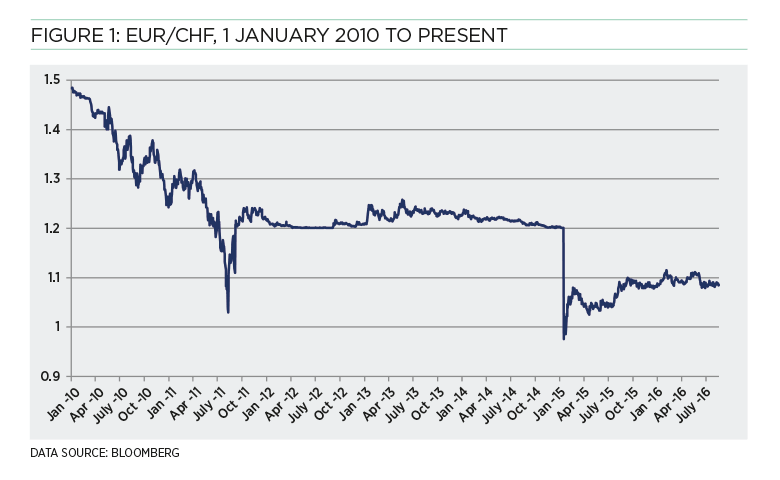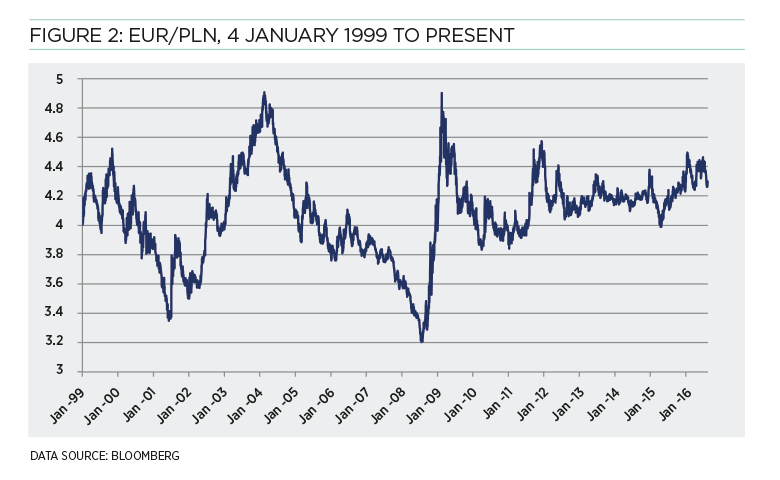
In a volatile world, treasurers need to be careful what they rely on. Relationships and correlations between currencies, which for a long time appeared reliable, have recently shown a tendency to break down. These breakdowns usually occur at a time of general economic stress, and the fallout is often dramatic.
Recently, the most extreme example is the EUR/CHF currency pair. It was floored at 1.2000 by the Swiss National Bank (SNB) on 6 September 2011 and the floor was defended by the SNB selling CHF and buying EUR (see Figure 1, below). However, the SNB did not ‘sterilise’ its intervention in the markets – ie, it did not sell government bonds to soak up the extra supply of CHF.

Although this policy could have gone on ad infinitum from a pure currency perspective (since a central bank can always turn to the printing presses and never run out of its own currency to sell), from a money-supply perspective, there were always going to be limits to the policy’s duration.
This is because every unsterilised Swiss franc that was printed added to the Swiss money supply. One of the main reasons for the intervention in the first place was to avoid deflation. However, a spiralling money supply eventually unnerved the SNB, and on 15 January 2015, it abandoned the EUR/CHF floor.
The exchange rate plummeted by some 30% on the day – so anyone who was relying on the continuation of the 1.2000 floor was suddenly completely wrong-footed.
Another currency pair, the ongoing stability of which it would be imprudent to rely on, is EUR/PLN. Indeed, this may be an accident waiting to happen. Figure 2, below, shows the history of this currency pair since the euro’s inception on 1 January 1999.

The past five years have seen the rate range bound between broadly 4.0000 and 4.5000. Encouraged by Poland’s enthusiastic membership of the EU, and the recent relative stability of the exchange rate, some have been prompted to regard the PLN as a proxy for the euro. This could be a very dangerous notion.
Were one or more eurozone members to leave, it is not clear whether the euro would be stronger or weaker – it would depend on who left. A euro without Germany would leave the single currency as weak as a kitten. Certainly, EUR/PLN would be highly unlikely to remain in the 4.0000 to 4.5000 range.
It is not just reliance on correlations that can wreak havoc in corporate treasuries. Many businesses also have loose or formal arrangements with their suppliers or customers to share in the pain or gain from substantial FX movements.
Yet, even formal agreements can be subject to hasty renegotiation in difficult times, and loose agreements have a habit of disappearing completely.
For example, in the aftermath of the financial crisis, suppliers of imported food products, who had looked for support from their supermarket customers during previous bouts of sterling weakness, found it very difficult to push through price rises.
They face the same problem once again, in that the fall in GBP/EUR since the referendum has occurred against the backdrop of a sharp fall in general business confidence. This, combined with fierce supermarket price wars, means the supermarket buyers are in no mood to help out suppliers by paying more for imported products.
This is the iron law of FX: large currency movements always happen for a reason. In many cases, the underlying cause of the movement will make it even more difficult to cope with, whether it’s a financial crisis or an unanticipated political event.
Some companies, perhaps due to a lack of experience, could make the mistake of assuming that since they pay for certain imported inputs in sterling, they are not exposed to currency risk.
While this may be convenient in times of stable exchange rates, in the event of a decent downward move of the pound, suppliers will quickly raise their sterling prices in order to maintain their prices in terms of their own reporting currency. The pricing of some manufacturing inputs may be even more nuanced.
Relationships and correlations between currencies, which for a long time appeared reliable, have recently shown a tendency to break down
For instance, a manufacturer using oil-based products from the eurozone is likely to be exposed to the dollar, rather than the euro, since oil is priced in dollars.
As if all of this were not tricky enough, companies have to contend with the competition. Even if a firm manages to avoid being lulled into a false sense of security offered by a particular consensus view and seeks to hedge itself in order to protect against adverse currency movements, it must still consider the actions of its competitors.
Importers trading in products that have few substitutes might be assumed to be in the same boat. In the case of sterling weakness, eventually they will all have to raise prices. Although, those who have hedged will be able to hold out for longer and potentially increase market share.
However, in the case of sterling strength, the unhedged will be able to pass on some of the benefit to customers, whereas those who locked in to a worse rate will not have that option.
This is a powerful argument for incorporating optionality into the hedging strategy to avoid locking in. For exporters, the situation is often even more complicated, as they may be facing competitors who report in a range of different currencies.
A UK producer exporting to Germany may, through a combination of sensible hedging and some ability to pass on price rises, feel comfortable with GBP/EUR risk, only to find that weakness in the Thai baht, for example, suddenly provides the Thai competition with an opportunity to gain market share.
Alternatively, an exporter of goods or services may be competing with domestic manufacturers in the export market, who face little or no FX risk. In this circumstance, sterling strength, if unhedged, could prove disastrous, since, depending on the price elasticity of demand for the export, there may be little ability to pass on currency-induced price increases.
As we have seen from EUR/CHF and longer-term historical movements in EUR/PLN, seemingly stable currency pairs have the potential to surprise. And, it can be perilous to rely on the consensus, as the recent EU referendum demonstrated.
Attempts to share the pain or gain of currency movements with customers or suppliers are often successful when the movements are relatively small and when times are good. However, when movements are large, they are often accompanied by some general economic malaise for at least one of the parties.
Some companies may be able to reprice when input costs rise or their reporting currency appreciates. Though the ability to do this will depend very much on the market for the product or service, and on competition.
For those operating in competitive markets, neither currency stability nor relationships with customers or suppliers should be taken for granted. In these circumstances, the sensible use of derivatives to create a flexible hedging strategy becomes crucial.
James Stretton is a director at financial risk advisers JC Rathbone Associates. He has nearly 30 years’ experience in FX risk management.
This article was taken from the October 2016 issue of The Treasurer magazine. For more great insights, log in to view the full issue or sign up for eAffiliate membership
